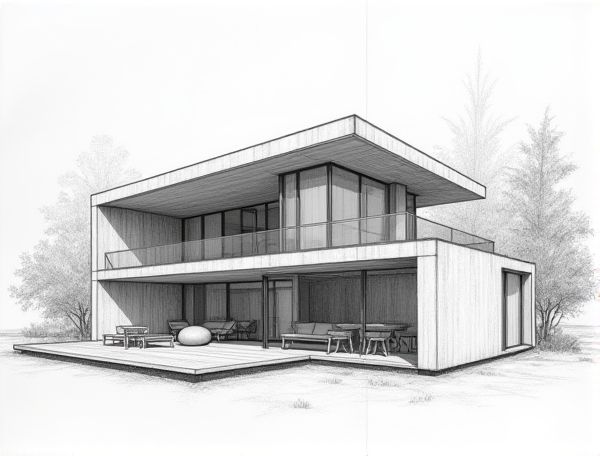
Photo illustration: Minimalist home design with acoustic insulation for recording studios
Minimalist home design enhances your recording studio by creating a clutter-free environment that promotes focus and creativity while integrating advanced acoustic insulation to minimize sound interference. Explore the article for expert tips on achieving the perfect balance between sleek aesthetics and optimal sound quality in your space.
Introduction to Minimalist Home Design for Recording Studios
Minimalist home design for recording studios emphasizes clean lines, functional spaces, and the reduction of visual clutter to enhance acoustics and creativity. Incorporating sound-absorbing materials, optimized furniture placement, and neutral color palettes ensures an efficient, distraction-free environment ideal for music production.
Key Principles of Minimalism in Studio Spaces
Minimalism in studio spaces emphasizes clean lines, open layouts, and multifunctional furniture to maximize usability and aesthetic appeal while reducing clutter. Neutral color palettes paired with natural light sources enhance spatial perception and foster a calm, inviting atmosphere. Prioritizing simplicity and functionality encourages efficient use of limited square footage, creating a harmonious environment that supports creativity and productivity.
Importance of Acoustic Insulation in Home Studios
Acoustic insulation in home studios significantly enhances sound quality by reducing external noise and preventing sound leakage, ensuring clearer recordings and better mixing accuracy. Your creative process benefits from a controlled acoustic environment, minimizing distractions and allowing precise audio monitoring.
Integrating Soundproofing in Minimalist Interiors
Integrating soundproofing in minimalist interiors enhances acoustic comfort without compromising clean lines and simplicity. Using materials such as acoustic panels, dense insulation, and sound-absorbing textiles ensures noise reduction while maintaining a sleek aesthetic. Strategic placement of soundproofing elements behind walls, ceilings, and furniture optimizes functionality and preserves the minimalist design ethos.
Essential Materials for Acoustic Treatment
Essential materials for acoustic treatment include high-density fiberglass panels, acoustic foam, and mineral wool, which effectively absorb sound waves and reduce echo in your living spaces. Bass traps are crucial for managing low-frequency sounds, while diffusers help scatter sound evenly to maintain natural room acoustics. Selecting the right combination of these materials ensures your home design supports optimal sound quality and comfort.
Space Optimization: Furniture and Layout Choices
Maximizing space efficiency in home design requires selecting multifunctional furniture such as foldable tables, storage ottomans, and wall-mounted shelves that reduce clutter and enhance usability. Strategic layout choices, including open floor plans and the use of vertical space, allow for better flow and increased living area without expanding the footprint. Utilizing modular furniture pieces enables customization according to room size and needs, optimizing both comfort and functionality in small or irregular spaces.
Color Palettes and Surface Selection for Acoustic Performance
Selecting color palettes that incorporate muted tones such as soft grays, deep blues, and earthy greens enhances acoustic comfort by reducing light reflection and creating a soothing environment. Opting for surface materials like acoustic panels, textured fabrics, and perforated wood not only improves sound absorption but also complements the visual aesthetic, balancing style with functional sound control.
Balancing Aesthetics and Functionality
Achieving balance between aesthetics and functionality in home design involves selecting materials and layouts that enhance visual appeal while ensuring practical use and comfort. Incorporating multi-functional furniture and optimizing natural light contribute to a harmonious environment that supports daily living without compromising style.
Sustainable Solutions for Minimalist Studio Design
In minimalist studio design, sustainable solutions prioritize energy-efficient lighting, eco-friendly materials such as bamboo and reclaimed wood, and smart insulation techniques to reduce environmental impact. Integrating multifunctional furniture and maximizing natural light enhances space utility while promoting a reduced carbon footprint.
Final Tips for Creating a Minimalist, Acoustically Treated Studio
Achieving a minimalist, acoustically treated studio requires careful selection of sound-absorbing materials like acoustic panels, bass traps, and diffusers to control reverberation and enhance sound clarity. You should optimize the studio layout by positioning furniture and equipment to minimize sound reflections and utilize neutral color palettes to maintain a clean, distraction-free environment. Prioritizing natural light and cable management improves both functionality and aesthetics, ensuring your creative space is efficient and visually calming.
 homedesy.com
homedesy.com